Little Tobago:
Haven on Earth
Text and photos by Jon
Hill
June 2004
Return
to Articles Page
I wonder if
Robinson Crusoe, rumored to have spent his legendary days on the bigger
sister of this island, ever saw and felt the scene before me.
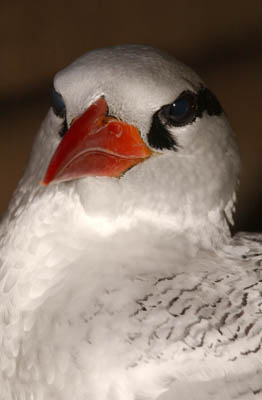 Hardly
breathing, I scoot to within a few feet of the pair. Two sets of eyes
like polished onyx peer unblinking from beneath the broad sheltering
leaves of an Anthurium. The contrast of brilliant white plumage and
red-orange bill against the muted greens and browns of the undergrowth
makes it tough for my quarry to hide. A hungry Crusoe probably would
have been a real threat to these vulnerable, trusting creatures. Fortunately,
I'm the only potential predator on the island, and the only shooting
I'll do today is with a camera. My subjects are the Red-billed Tropicbirds
who nest here from November to March. I'm spending the day on Little
Tobago.
Hardly
breathing, I scoot to within a few feet of the pair. Two sets of eyes
like polished onyx peer unblinking from beneath the broad sheltering
leaves of an Anthurium. The contrast of brilliant white plumage and
red-orange bill against the muted greens and browns of the undergrowth
makes it tough for my quarry to hide. A hungry Crusoe probably would
have been a real threat to these vulnerable, trusting creatures. Fortunately,
I'm the only potential predator on the island, and the only shooting
I'll do today is with a camera. My subjects are the Red-billed Tropicbirds
who nest here from November to March. I'm spending the day on Little
Tobago.
Close encounters
with wildlife are getting rare in our expanding world of industrialization
and urbanization. Little Tobago is a sanctuary for seabirds. Here
they are safe from pollution and bulldozers. The island is also a
sanctuary for me. Here I can forget for a few hours. Here I can step
outside time and enjoy the presence of creatures that have little
experience with people and no particular reason to fear them. Here
I can sit and watch and wonder and give a prayer of thanks to Crusoe's
God for the beauty around me.
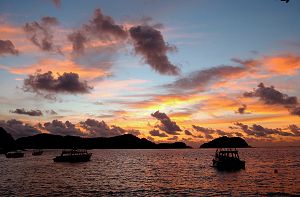 The
island of Little Tobago sits off the northeast coast of Tobago in
the West Indies. My journey this morning started with a rocky 15-minute
boat ride from the fishing village of Speyside. The glass-bottom boats
depart twice a day with a few visitors who want to hike on Little
Tobago for an hour, catch glimpses of corals and fish through the
bottom of the boat, and spend half an hour of snorkeling around tiny
Goat Island. Many tourists seem more interested in the impressive
house on Goat Island than in the countless species of fish, the largest
brain-coral in the world, and the occasional manta ray. The house,
besieged but not taken by the twice-a-day tide, once belonged to Ian
Fleming, creator of James Bond.
The
island of Little Tobago sits off the northeast coast of Tobago in
the West Indies. My journey this morning started with a rocky 15-minute
boat ride from the fishing village of Speyside. The glass-bottom boats
depart twice a day with a few visitors who want to hike on Little
Tobago for an hour, catch glimpses of corals and fish through the
bottom of the boat, and spend half an hour of snorkeling around tiny
Goat Island. Many tourists seem more interested in the impressive
house on Goat Island than in the countless species of fish, the largest
brain-coral in the world, and the occasional manta ray. The house,
besieged but not taken by the twice-a-day tide, once belonged to Ian
Fleming, creator of James Bond.
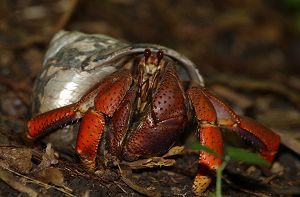 For
me, the boat to Goat Island and Little Tobago is just transport to
the place of my escape. I've seen Mr. Fleming's house and the brain
coral a few times before and had a great underwater experience yesterday
with a local dive guide. Today I'm fixed on my goal, to photograph
nesting Red-billed Tropicbirds. The guides will give their little
tour to the uninitiated but I will leave them for trails less-traveled.
Most visitors stay just long enough to learn that the birds aren't
all seagulls and then they leave, but I'm arriving on the first boat
of the day and I'll leave on the last, with six hours or so of solitude
in between.
For
me, the boat to Goat Island and Little Tobago is just transport to
the place of my escape. I've seen Mr. Fleming's house and the brain
coral a few times before and had a great underwater experience yesterday
with a local dive guide. Today I'm fixed on my goal, to photograph
nesting Red-billed Tropicbirds. The guides will give their little
tour to the uninitiated but I will leave them for trails less-traveled.
Most visitors stay just long enough to learn that the birds aren't
all seagulls and then they leave, but I'm arriving on the first boat
of the day and I'll leave on the last, with six hours or so of solitude
in between.
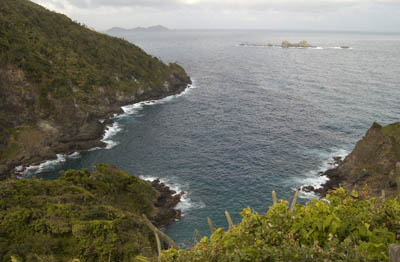 Little
Tobago juts out of the sea steeply. Waves out of the Atlantic pound
its rocky shores while wind-blown foliage including strange cacti
conforms to the will of a persistent wind from the east. Forests of
fan palms and hardwoods with a sparse ground cover of broad-leaved
Anthurium fill in the leeward hollows. Numerous trails provide many
hours of moderate hiking and I take to these with a long, eager stride.
Little
Tobago juts out of the sea steeply. Waves out of the Atlantic pound
its rocky shores while wind-blown foliage including strange cacti
conforms to the will of a persistent wind from the east. Forests of
fan palms and hardwoods with a sparse ground cover of broad-leaved
Anthurium fill in the leeward hollows. Numerous trails provide many
hours of moderate hiking and I take to these with a long, eager stride.
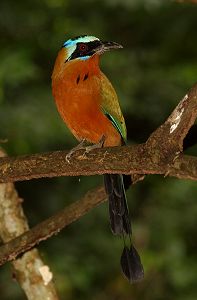 I
share the trails with an odd assortment of hermit crabs, lizards,
and feral chickens. None are in any particular hurry to get out of
my way though none are bold or stupid enough to ignore my presence.
Tropical Mockingbirds, Blue-Crowned Mot-mots, and several species
of passerines chatter as they flit by or watch silently from branches.
Birds of Paradise from New Guinea were introduced here many decades
ago, giving Little Tobago its earlier name of Bird of Paradise Island.
But now they gone, wiped out in a hurricane in the sixties. A twisted
chain-link cage next to the trails speaks of an unsuccessful reintroduction
program. Little Tobago is what it is and seems to resist our efforts
to change it.
I
share the trails with an odd assortment of hermit crabs, lizards,
and feral chickens. None are in any particular hurry to get out of
my way though none are bold or stupid enough to ignore my presence.
Tropical Mockingbirds, Blue-Crowned Mot-mots, and several species
of passerines chatter as they flit by or watch silently from branches.
Birds of Paradise from New Guinea were introduced here many decades
ago, giving Little Tobago its earlier name of Bird of Paradise Island.
But now they gone, wiped out in a hurricane in the sixties. A twisted
chain-link cage next to the trails speaks of an unsuccessful reintroduction
program. Little Tobago is what it is and seems to resist our efforts
to change it.
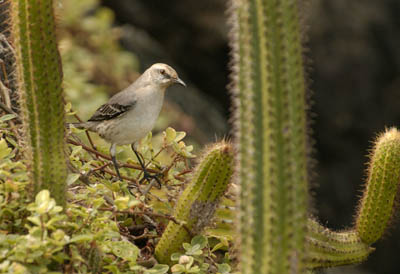
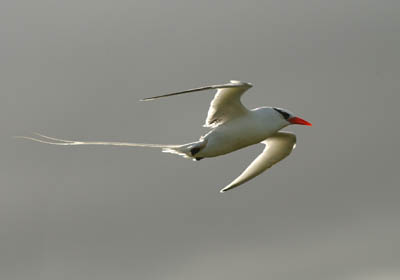 Finally
reaching a crest with a view to the east, the sun and wind create
a dazzling view of the heaving sea a hundred or so meters below me.
A few tropicbirds, boobies, and frigatebirds soar on the updrafts,
but I know the skies will be riotous later on when the masses return
from their day of foraging on the open sea. Still I can't help but
stop and watch a few of the graceful white tropicbirds as they hurtle
past, their tails as long as their bodies and beaks the color of hot
coals. I recall hearing that this was the spot where David Attenborough's
team filmed them several years before. A quick sip of water, and I'm
off into the forest again.
Finally
reaching a crest with a view to the east, the sun and wind create
a dazzling view of the heaving sea a hundred or so meters below me.
A few tropicbirds, boobies, and frigatebirds soar on the updrafts,
but I know the skies will be riotous later on when the masses return
from their day of foraging on the open sea. Still I can't help but
stop and watch a few of the graceful white tropicbirds as they hurtle
past, their tails as long as their bodies and beaks the color of hot
coals. I recall hearing that this was the spot where David Attenborough's
team filmed them several years before. A quick sip of water, and I'm
off into the forest again.
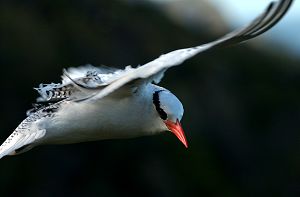 Approaching
another crest, well away from the tourist route, I slow and begin
to scan the forest floor for bits of white. A few snowy feathers beyond
a fallen log catch my eye and my heart beats a little louder as I
try to get a better viewing angle. Finally there's an opening in the
leaves and we see each other.
Approaching
another crest, well away from the tourist route, I slow and begin
to scan the forest floor for bits of white. A few snowy feathers beyond
a fallen log catch my eye and my heart beats a little louder as I
try to get a better viewing angle. Finally there's an opening in the
leaves and we see each other.
No one runs
away. I'm allowed to watch on a trial basis. The next hour with these
two perfect creatures will pass in a blink and be enjoyed for years
as a memory and a few photographs. Even if Robinson Crusoe never did
see this, being here, saturated in the Tobago experience, will surely
animate my next reading of Defoe's account.
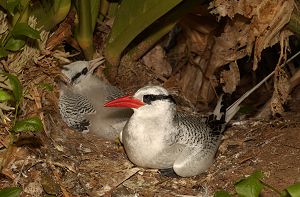
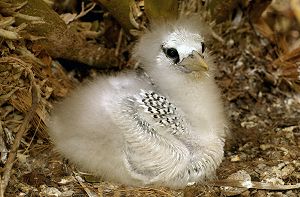
Return
to Articles Page
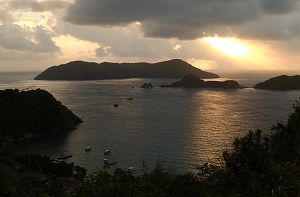

 Hardly
breathing, I scoot to within a few feet of the pair. Two sets of eyes
like polished onyx peer unblinking from beneath the broad sheltering
leaves of an Anthurium. The contrast of brilliant white plumage and
red-orange bill against the muted greens and browns of the undergrowth
makes it tough for my quarry to hide. A hungry Crusoe probably would
have been a real threat to these vulnerable, trusting creatures. Fortunately,
I'm the only potential predator on the island, and the only shooting
I'll do today is with a camera. My subjects are the Red-billed Tropicbirds
who nest here from November to March. I'm spending the day on Little
Tobago.
Hardly
breathing, I scoot to within a few feet of the pair. Two sets of eyes
like polished onyx peer unblinking from beneath the broad sheltering
leaves of an Anthurium. The contrast of brilliant white plumage and
red-orange bill against the muted greens and browns of the undergrowth
makes it tough for my quarry to hide. A hungry Crusoe probably would
have been a real threat to these vulnerable, trusting creatures. Fortunately,
I'm the only potential predator on the island, and the only shooting
I'll do today is with a camera. My subjects are the Red-billed Tropicbirds
who nest here from November to March. I'm spending the day on Little
Tobago. The
island of Little Tobago sits off the northeast coast of Tobago in
the West Indies. My journey this morning started with a rocky 15-minute
boat ride from the fishing village of Speyside. The glass-bottom boats
depart twice a day with a few visitors who want to hike on Little
Tobago for an hour, catch glimpses of corals and fish through the
bottom of the boat, and spend half an hour of snorkeling around tiny
Goat Island. Many tourists seem more interested in the impressive
house on Goat Island than in the countless species of fish, the largest
brain-coral in the world, and the occasional manta ray. The house,
besieged but not taken by the twice-a-day tide, once belonged to Ian
Fleming, creator of James Bond.
The
island of Little Tobago sits off the northeast coast of Tobago in
the West Indies. My journey this morning started with a rocky 15-minute
boat ride from the fishing village of Speyside. The glass-bottom boats
depart twice a day with a few visitors who want to hike on Little
Tobago for an hour, catch glimpses of corals and fish through the
bottom of the boat, and spend half an hour of snorkeling around tiny
Goat Island. Many tourists seem more interested in the impressive
house on Goat Island than in the countless species of fish, the largest
brain-coral in the world, and the occasional manta ray. The house,
besieged but not taken by the twice-a-day tide, once belonged to Ian
Fleming, creator of James Bond. For
me, the boat to Goat Island and Little Tobago is just transport to
the place of my escape. I've seen Mr. Fleming's house and the brain
coral a few times before and had a great underwater experience yesterday
with a local dive guide. Today I'm fixed on my goal, to photograph
nesting Red-billed Tropicbirds. The guides will give their little
tour to the uninitiated but I will leave them for trails less-traveled.
Most visitors stay just long enough to learn that the birds aren't
all seagulls and then they leave, but I'm arriving on the first boat
of the day and I'll leave on the last, with six hours or so of solitude
in between.
For
me, the boat to Goat Island and Little Tobago is just transport to
the place of my escape. I've seen Mr. Fleming's house and the brain
coral a few times before and had a great underwater experience yesterday
with a local dive guide. Today I'm fixed on my goal, to photograph
nesting Red-billed Tropicbirds. The guides will give their little
tour to the uninitiated but I will leave them for trails less-traveled.
Most visitors stay just long enough to learn that the birds aren't
all seagulls and then they leave, but I'm arriving on the first boat
of the day and I'll leave on the last, with six hours or so of solitude
in between. Little
Tobago juts out of the sea steeply. Waves out of the Atlantic pound
its rocky shores while wind-blown foliage including strange cacti
conforms to the will of a persistent wind from the east. Forests of
fan palms and hardwoods with a sparse ground cover of broad-leaved
Anthurium fill in the leeward hollows. Numerous trails provide many
hours of moderate hiking and I take to these with a long, eager stride.
Little
Tobago juts out of the sea steeply. Waves out of the Atlantic pound
its rocky shores while wind-blown foliage including strange cacti
conforms to the will of a persistent wind from the east. Forests of
fan palms and hardwoods with a sparse ground cover of broad-leaved
Anthurium fill in the leeward hollows. Numerous trails provide many
hours of moderate hiking and I take to these with a long, eager stride. I
share the trails with an odd assortment of hermit crabs, lizards,
and feral chickens. None are in any particular hurry to get out of
my way though none are bold or stupid enough to ignore my presence.
Tropical Mockingbirds, Blue-Crowned Mot-mots, and several species
of passerines chatter as they flit by or watch silently from branches.
Birds of Paradise from New Guinea were introduced here many decades
ago, giving Little Tobago its earlier name of Bird of Paradise Island.
But now they gone, wiped out in a hurricane in the sixties. A twisted
chain-link cage next to the trails speaks of an unsuccessful reintroduction
program. Little Tobago is what it is and seems to resist our efforts
to change it.
I
share the trails with an odd assortment of hermit crabs, lizards,
and feral chickens. None are in any particular hurry to get out of
my way though none are bold or stupid enough to ignore my presence.
Tropical Mockingbirds, Blue-Crowned Mot-mots, and several species
of passerines chatter as they flit by or watch silently from branches.
Birds of Paradise from New Guinea were introduced here many decades
ago, giving Little Tobago its earlier name of Bird of Paradise Island.
But now they gone, wiped out in a hurricane in the sixties. A twisted
chain-link cage next to the trails speaks of an unsuccessful reintroduction
program. Little Tobago is what it is and seems to resist our efforts
to change it.
 Finally
reaching a crest with a view to the east, the sun and wind create
a dazzling view of the heaving sea a hundred or so meters below me.
A few tropicbirds, boobies, and frigatebirds soar on the updrafts,
but I know the skies will be riotous later on when the masses return
from their day of foraging on the open sea. Still I can't help but
stop and watch a few of the graceful white tropicbirds as they hurtle
past, their tails as long as their bodies and beaks the color of hot
coals. I recall hearing that this was the spot where David Attenborough's
team filmed them several years before. A quick sip of water, and I'm
off into the forest again.
Finally
reaching a crest with a view to the east, the sun and wind create
a dazzling view of the heaving sea a hundred or so meters below me.
A few tropicbirds, boobies, and frigatebirds soar on the updrafts,
but I know the skies will be riotous later on when the masses return
from their day of foraging on the open sea. Still I can't help but
stop and watch a few of the graceful white tropicbirds as they hurtle
past, their tails as long as their bodies and beaks the color of hot
coals. I recall hearing that this was the spot where David Attenborough's
team filmed them several years before. A quick sip of water, and I'm
off into the forest again. Approaching
another crest, well away from the tourist route, I slow and begin
to scan the forest floor for bits of white. A few snowy feathers beyond
a fallen log catch my eye and my heart beats a little louder as I
try to get a better viewing angle. Finally there's an opening in the
leaves and we see each other.
Approaching
another crest, well away from the tourist route, I slow and begin
to scan the forest floor for bits of white. A few snowy feathers beyond
a fallen log catch my eye and my heart beats a little louder as I
try to get a better viewing angle. Finally there's an opening in the
leaves and we see each other. 
